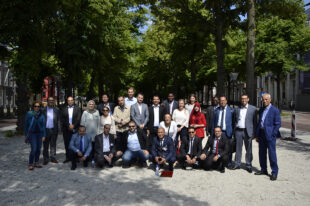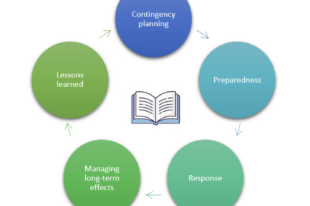New Path to Success Unanimously Embraced

The adoption of the next strategic plan gives us a great opportunity to look ahead and discuss how we want INTOSAI to grow and where we should focus our energy.
Dr. Harab Al Amimi, State Audit Institution, UAE
Some 12 years ago, 187 members unanimously adopted the International Organization of Supreme Audit Institution’s (INTOSAI) first strategic plan at the 2004 Budapest Congress. Fast forward to INCOSAI XXII, and INTOSAI, once again, faces a landmark moment with the roll out of the Strategic Plan 2017-2022.
The plan establishes a new and exciting path for INTOSAI, a path that will better position the organization and each SAI to take advantage of emerging opportunities to provide value and benefits to our stakeholders and fellow citizens.
In presenting the plan for endorsement at the congress, U.S. Comptroller Gene L. Dodaro, who led INTOSAI’s Strategic Planning Task Force, indicated the plan presents an improved way of doing business for INTOSAI.
“The plan is based on a more strategic, agile, and integrated approach, capable of responding to global development efforts as well as other current and emerging opportunities and challenges,” noted Dodaro.
Guided by a process firmly grounded in consultation and consent, this strategic planning process truly exemplified the INTOSAI motto, “Mutual Experience Benefits All.” An extensive internal and external scanning effort of the Task Force provided INTOSAI members and SAIs with an opportunity to provide input and comment on the plan while it was being developed. The scans were organized around three main themes: what worked well, what could be improved, and what changes, if any, are needed for the future.
The scans showed consensus among member SAIs that the current strategic goals generally capture the direction and results that INTOSAI hopes to achieve going forward. Accordingly, the plan includes four strategic goals under which INTOSAI broadly organizes its work. They include: (1) professional standards; (2) capacity development; (3) knowledge sharing and knowledge services; and (4) maximize the value of INTOSAI as an international organization.
At the same time, the scan results revealed INTOSAI needs to change the way it operates to be more effective and to meet emerging opportunities and needs. The plan introduces five crosscutting priorities to support such changes:
- Advocating for and supporting the independence of Supreme Audit Institutions (SAIs)
- Contributing to the follow-up and review of the Sustainable Development Goals (SDGs) within the context of each nation’s specific sustainable development efforts and SAIs’ individual mandates
- Ensuring effective development and coordination among standards-setting, capacity development and knowledge sharing to support SAIs and improve their performance and effectiveness
- Creating a strategic and agile INTOSAI that is alert to, and capable of responding to, emerging international opportunities and risks
- Building upon, leveraging and facilitating cooperation and professionalism among INTOSAI regional organizations
In addition to the crosscutting priorities, there are a number of very important features designed to help chart a new way forward, including the vital role INTOSAI plays as a global public voice for SAI independence, external public sector auditing and good governance.
The plan formally recognizes establishing communities of practice, the common forum on standard setting, regional development forums, as well as the INTOSAI Development Initiative (IDI)-Knowledge Sharing Committee (KSC) capacity development program on auditing implementation of the 2030 Agenda for Sustainable Development.
The Strategic Plan 2017-2022 includes a commitment to performance assessments and reporting against a set of strategic objectives along with a pledge to implement a concerted enterprise risk management program.
The plan articulates the respective roles and responsibilities for SAI capacity development recognizing that individual SAIs are at the center of those efforts, as are the efforts of key stakeholders and initiatives, such as IDI, the Capacity Building Committee, and the INTOSAI-Donor Cooperation.
At the same time, the plan ensures that our ambitions are realistic and appropriate given the financial realities and resource constraints we all face.
Dr. Harib Al Amimi, President of the State Audit Institution, United Arab Emirates, expressed his sentiments regarding the success of the strategic plan and INTOSAI.
“The adoption of the next strategic plan gives us a great opportunity to look ahead and discuss how we want INTOSAI to grow and where we should focus our energy,” Al Amimi emphasized.
While there is a clear path for our way ahead through 2022, it is also important to ensure that what is accomplished now leads to even more success in the future.
“It is important for us to realize the expected results from the strategic plan,” commented Shourjo Chatterjee, Strategy and Knowledge Manager of the INTOSAI Development Initiative.
Chatterjee added that the crosscutting strategic priorities are to be driven by the goal committees and believes advanced coordination and planning are crucial to ensuring no priority is left behind, that no priority is promoted at the expense of another.
Dr. Hussam Al Angari, President of the General Auditing Bureau of Saudi Arabia and Chair of the Financial Accounts Committee, agrees, “As it is stated in the strategic plan, we need INTOSAI and all of the goal chairs to work in the best possible manner.”
From the regional perspective, Mr. Tan Sri Dato’ Setia Haji Ambrin Bin Buang, Auditor General of Malaysia and Chair of the Asian Organization of Supreme Audit Institutions (ASOSAI), believes the time has come for implementation.
“ASOSAI has to align the strategic plan as well as the activities to ensure that the objectives will be successfully implemented at the regional level.”
Khalid Hamid, Executive Director of the Department of Professional Services with the State Audit Institution of the United Arab Emirates believes “the way INTOSAI has evolved is fantastic, the way in which we are a community is brilliant.”
Hamid furthered that we need to work out how we get the best return on the investment of all our in-kind contributions in a way that gives most value back to the organization.
“We have the infrastructure. We have the ability. We definitely have the people. What we need now is a way to harness it in a more agile way as the Strategic Plan says.”





